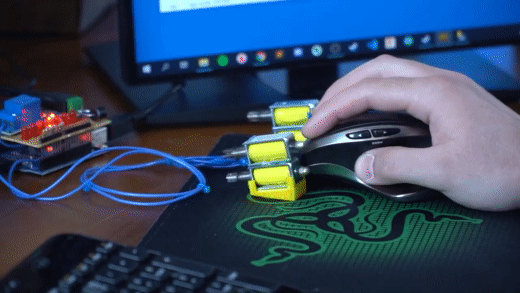Rumble first hit the gaming mainstream back in the mid-1990s, and has become de rigeur for console players using gamepads ever since. It’s less prevalent on the PC, because most players rely on keyboards and mice that are rumble-free. However, innovation is possible, and [ilge] put together a modified mouse for shooters that has an excellent recoil feedback device.
The feedback effect is run by an Arduino, which receives serial data from a Python program running on the host computer. When the mouse is clicked, the Python program notifies the Arduino, which then fires a bank of four solenoids repeatedly back-and-forth to generate the feedback effect. The solenoids are triggered by a relay, which is an easy way to switch such a load, though we suspect it may not hold up well over time due to the rapid fire rate and the likelihood of spark damage over time from high inrush current to the solenoids.
It’s a simple build that nonetheless adds a great haptic feedback effect to the otherwise humble computer mouse. While we don’t expect to see pros using the device anytime soon, it’s a great concept that does add to the shooter experience. Similar hardware could likely be put to great use in a VR context, too. The state of the art of haptic technology continues to move at a rapid pace, and we can’t wait to see what comes next. Video after the break.
















Logitech made a tactile feedback mouse many years ago. Used to have one. Concept was fun but not very usefull.
> Concept was fun but not very usefull.
The full RGB animated LED lighting on my motherboard, RAM, CPU cooler, and mouse prove usefulness doesn’t matter when it comes to PC gaming hardware.
video games aren’t very useful
https://en.wikipedia.org/wiki/Serious_game
It’s a cool feature, it’s nice to see the feedback being in line with the mouse movement rather than just a rumble.
Neat loll
love the video! keep up the good work 🤘
I was kind of hoping that they had tapped into the force feedback function from their game rather than just listening to which mouse buttons are pressed. I can’t blame them for doing it this way though.
Remind me of the RumbleFX Force Feeadback headphone ^^ (http://www.dansdata.com/rfxphones.htm)
Invitation to arthrosis :-)
much like real recoil, this will affect the follow up shots
Getting extra gun climb in FPSes that already simulate it must be awful :-P
Actually, it looks like it might partially cancel it out. The haptics appear to push the mouse backwards in the GIF, which would somewhat correct for climb.
I actually assumed that was the original intent, but I imagine that would be somewhat difficult to tune perfectly.
it’s zero-sum recoil, so it’ll shake but not climb or cancel
it would be great to get variable strength recoil for different weapons. like previous comments said that woiuld need to hook in to the game somehow, could also provide hit feedback
An accurate recoil mouse could be a big problem if you were in a World War II themed game and accidentally picked up a Mosin Nagant.
Thought I was having a deja vu but a similar project was posted in May;
https://hackaday.com/2020/05/17/force-feedback-mouse-really-shakes-things-up/
Seems like a fun project to build :)
The solenoids do not have ANY inrush current. In the opposite, an inductance does not “like” current changes, therefore it creates an inductive spike, which can damage contacts and transistors. The common solution against this in a DC circuit is a freewheeling diode. But another effect of this diode is to extend demagnetization time (release of the solenoid) if this is unwanted, you can use a varistor or zener clamping.
Your comment got me thinking, just like that one pesky student who asks the brain-stumping questions in class. Inrush current on power transformers is definitely a thing, but circuit theory won’t explain it if you model transformers as ideal with a series inductance. The key is the nonlinear BH curve. Google “transformer inrush in 5 minutes” for a good explanation. So given the steel cores, these solenoids should indeed have inrush current as opposed to an air-core inductor.
PS: You are probably right that the real issue is the big voltage spike on turn off.
Yes, the collapsing magnetic field that occurs when the power is removed acts as s generator and creates an inductive kick that can spark and erode contacts. This leads to extra resistance when the contacts are engaged which then causes heating while engaged, continuously. This is how switchgear early detection of contact issues works, eg thermal camera or some kind of sniffer.
Maybe it is time hackaday had a really and contacts article, there are many considerations, eg just one example is most people have no idea that many relay contacts have an important rating of minimum current, or life can be substantially shortened, due to the “self wiping” action not working properly.
So it is a real life AK47 when playing FPS